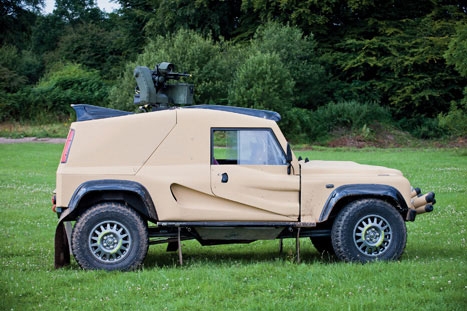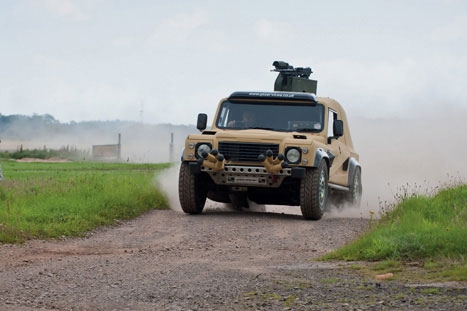A rugged 4x4 climbs to the top of a desert sand dune, tackling the ridge effortlessly before descending the other side at high speed and leaving the vehicles behind it in a plume of dust.
This is the kind of scene you might expect to see in the Dakar, a desert rally race once held across Africa and now based in South America. But a company in Devon is hoping to make scenarios such as this more common to army combat operations by becoming the first UK company to introduce a military vehicle originally designed for motorsport.
UK troops have been in Afghanistan for nearly a decade now, and the threat of guerrilla insurgents and improvised explosive devices (IEDs) has led to a trend for transport with more armour. Supacat thinks it’s time to go the other way.
’Military vehicles are becoming bigger, heavier and more protected and, as a result, more expensive,’ said Jamie Clarke, sales and marketing manager for the company, which is also behind other vehicles now used by the UK Ministry of Defence (MoD), including the Jackal and the Coyote.
It’s the Wildcat vehicle’s capabilities for dealing with difficult scenarios that made it suitable for military adaptation
’We’ve identified there’s a gap in the military market for something that is still very agile, very fast and that provides its protection because it has high mobility,’ he added.’ The sort of roles we think it could be deployed in are border patrol, rapid intervention, light strike or even the recovery of downed pilots; the kind of thing where you need to get in somewhere really quickly, you need some protection which is what the vehicle’s remote weapon station is all about and you need to get out quickly as well.’
Instead of designing a vehicle from scratch, Supacat turned to fellow Devon-based company Qt Services and its Wildcat rally raid off-roader. Privately owned Wildcats have finished in the top 20 of the Dakar three times an impressive feat for a vehicle that costs less than one-tenth of the million-plus pounds spent by major manufacturers on their entries.
’It’s built on a very lightweight tubular space frame chassis, and the inherent strength with that is that it’s very rigid and very light but also has a tremendously low centre of gravity so it gives it a tremendous stability,’ said Qt managing director Dave Marsh. ’Obviously, for our criteria, we need high manoeuvrability for operating in the dunes and extreme environments, so it has very good approach and departure angles.’

And it’s the Wildcat’s capabilities for dealing with difficult scenarios that made it a suitable contender for military adaptation. Instead of having to develop a typical off-roader to defence standards, Supacat found it had a vehicle that could already operate in the hot and dusty terrain of the desert but also in freezing temperatures and at high altitude.
’Another of the features that comes across from the motorsport side is in-built redundancy,’ said Marsh. ’The vehicle can be fitted with twin shock absorbers, so if you lose one the vehicle’s not totally incapacitated. The same goes with the electronics: all the circuitry in the car is independent, so if you lose a particular thing it doesn’t disable the vehicle entirely. And effectively the bodyshell is really a cloak you can lose the whole thing and the vehicle will continue to function.’
There were also advantages in the supply chain, which is accustomed to building high-performance components and delivering to tight deadlines. Supacat already employs 14 suppliers from the motorsport industry for parts for the Jackal, a robust cross-country vehicle currently used in Afghanistan.
The two companies have constructed a military technology demonstrator version of the Wildcat, with French-owned defence company Thales supplying the remote weapon system that sits on the roof. They expect to make further alterations once they secure contracts, but the vehicle has so far needed relatively few adaptations because it is already close to defence standards. In addition, Qt Services, which took over Wildcat manufacturing from Bowler Offroad in 2007, was accustomed to tailoring the vehicle to specific requirements for speed and stability.
“One of the things our clients love when they race is that the car is fantastic in the dunes”
’One of the big issues with this is making the car longer for high-speed work, whereas a nice short wheel base gives it great manoeuvrability in the dunes, and one of the things our clients particularly love when they race them in the desert is the car is fantastic in the dunes,’ said Marsh. ’We’ve got a really good balance of that factor now.’
The challenge will be enabling the car to retain its performance levels at a heavier weight; Qt expects a maximum payload of 2,500kg. Part of the solution may be to reduce the 380-litre fuel tank to around 200 litres, staying close to an impressive 2,000km range while leaving more room for ballistic armour.
Protection is an important issue when it comes to any military combat vehicle, especially in locations such as Afghanistan where threats can be hidden in the ground beneath you in the form of IEDs. But Clarke insisted there was still a place for a lighter vehicle. ’Protection on vehicles doesn’t always have to come from having a large chunk of metal,’ he said. ’Protection can also come from mobility. In some cases, you want to be in a large heavy metal box that does provide the ultimate protection, but that doesn’t necessarily mean that you’ve got terrain access.

’Protection can also come by the fact the vehicle is highly mobile, so the fact that it’s fast, it’s agile and it can access all terrain also provides protection because you can then get to the place where the enemy doesn’t expect you to be. You can come from a different direction and you can avoid predictable routes and therefore you’re less likely to encounter an IED in the first place. Protection through mobility is a capability in itself.’
Gary Pilchowski, business development manager at Thales, has a similar view. ’If you look at the IED threat, it’s channelled around the vehicles so it tends to be on roads and tracks, and from an insurgent’s perspective they assess your terrain accessibility. I think this vehicle opens all the boundaries and there isn’t anywhere it can’t go, so it’s significantly more difficult to hit. But arguably you trade that protection level [of armour].’
But there’s still a big question: will the military buy a combat vehicle without substantial physical protection? The MoD already has a light all-terrain vehicle called the Springer, designed for carrying cargo to forward operating bases. But it’s not the same as a combat vehicle.
’A big lesson learned in Afghanistan is that no one vehicle meets the requirement,’ said Clarke. ’You’ve got to have a fleet of vehicles for different threat conditions, different missions, and this is aimed at the high mobility, get in and get out, do the job very quickly. The idea is that it’s not necessarily a direct-fire support vehicle. It has self protection, so if you do get into trouble you can protect yourself, move quickly and get away from it.’
And there’s another reason the military should consider the Wildcat Supacat is hoping to make it available at around half the cost of an equivalent vehicle worth £500,000. ’Price wise, this is a lot cheaper than other vehicles on the market at the moment for the level of performance you get,’ said Clarke. If it works for private race drivers taking on some of the harshest environments on Earth, perhaps it could work for the MoD too.
Right on target
Remote weapon system enables soldiers to fire at enemies while sitting down
Sitting atop the Wildcat military demonstrator is the Kongsberg Super Lite remote weapon system, manufactured by Thales and already procured by the MoD for use in combat. Controlled by a screen and joystick inside the vehicle, it allows soldiers to target and fire at enemies from the relative safety of the front seat.
’We know the threat in theatre is either snipers or IEDs, yet we still choose to have soldiers stood up on a pintle mount,’ said Thales’ Gary Pilchowski. ’You need some form of protection and observation and I think this particular system offers both. You could crawl up to the top of a ridge line, have the remote weapon just looking over the top without actually exposing the vehicle and look around and pick your terrain.’




Glasgow trial explores AR cues for autonomous road safety
They've ploughed into a few vulnerable road users in the past. Making that less likely will make it spectacularly easy to stop the traffic for...